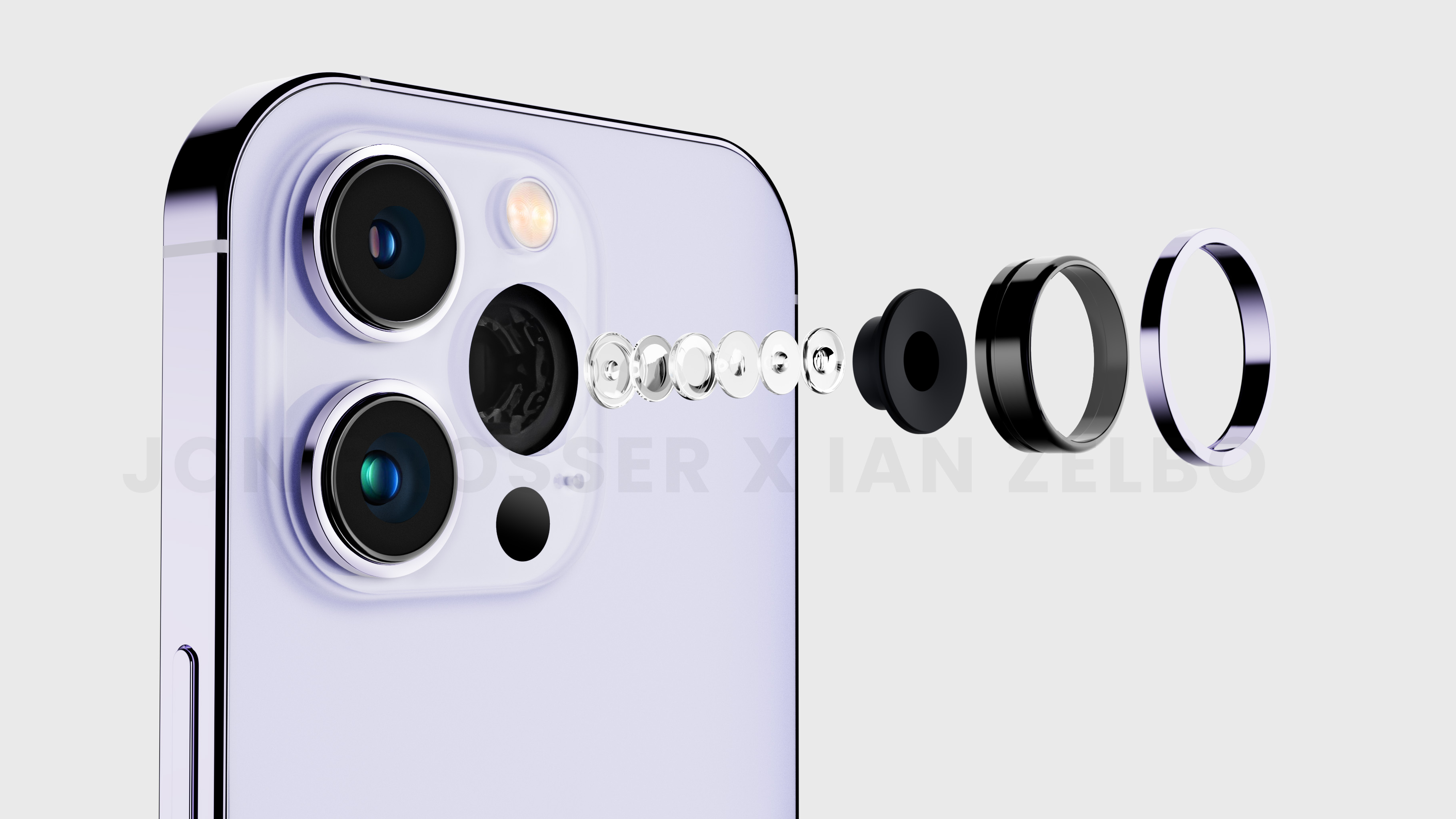 iPhone 14 concept render by Ian Zelbo based on purported leaked information
iPhone 14 concept render by Ian Zelbo based on purported leaked informationIn line with how Apple reserves its highest-end camera features for the "Pro" models, the iPhone 14 and iPhone 14 Max are expected to receive moderate camera improvements, with the more substantial changes being exclusive to the iPhone 14 Pro and iPhone 14 Pro Max to push iPhone photography to the limit.
iPhone 14 and iPhone 14 Max

iPhone 13 mini and iPhone 13
- 12-megapixel Wide camera with Focus Pixels
- 12-megapixel Ultra Wide camera with ƒ/2.4 aperture
- Front-facing camera with ƒ/2.2 aperture
iPhone 14 and iPhone 14 Max
- 12-megapixel Wide camera with Focus Pixels
- 12-megapixel Ultra Wide camera with ƒ/1.8 aperture and autofocus
- Front-facing camera with ƒ/1.9 aperture and autofocus
The iPhone 14's widely rumored new 48-megapixel Wide camera is expected to be exclusive to the Pro models, while the standard iPhone 14 models will retain a 12-megapixel Wide camera like the iPhone 13 lineup.
Earlier this year, Apple analyst Ming-Chi Kuo said that all four of the iPhone 14 models, including the iPhone 14, iPhone 14 Max, iPhone 14 Pro, and iPhone 14 Pro Max, will feature an upgraded front-facing camera with autofocus and a wider ƒ/1.9 aperture. The component is expected to cost Apple three times more.
A wider aperture would allow more light to pass through the lens and reach the front camera's sensor on the iPhone 14 models, resulting in enhanced image quality. Kuo said these camera upgrades could provide a better depth-of-field effect for Portrait mode photos and videos, while autofocus can improve focus during FaceTime and Zoom video calls. By comparison, the front camera on all of the iPhone 13 models has a fixed focus and a smaller ƒ/2.2 aperture.
Kuo correctly predicted that iPhone 13 Pro models would tout significantly upgraded Ultra Wide camera, increasing from ƒ/2.4 to ƒ/1.8 and from a five-element lens to a six-element lens, also gaining autofocus instead of the current fixed focus. In 2022, these upgrades to the Ultra Wide camera are expected to trickle down to the entire iPhone 14 lineup instead of being reserved for the Pro models.
iPhone 14 Pro and iPhone 14 Pro Max

iPhone 13 Pro and iPhone 13 Pro Max
- 12-megapixel Wide camera with Focus Pixels
- 6-element Telephoto lens
- 4K video recording
- Front-facing camera with ƒ/2.2 aperture
iPhone 14 Pro and iPhone 14 Pro Max
- 48-megapixel Wide camera with Focus Pixels and pixel binning
- 7-element Telephoto lens
- 8K video recording
- Front-facing camera with ƒ/1.9 aperture and autofocus
The 48-megapixel camera is the most widely rumored iPhone 14 camera feature. As a result of the increased number of megapixels, the iPhone 14 Pro's Wide camera pixels will be smaller, purportedly measuring at 1.22µm, according to a detailed rumor coming out of Asia. This is a reduction of 0.68µm compared to the iPhone 13 Pro and iPhone 13 Pro Max.
The new Wide sensor is believed to be a Sony unit, like the iPhone 13 Pro. Despite the change in pixel size, the iPhone 14 Pro will allegedly feature the same Dual Pixel Auto Focus (DPAF) system, marketed by Apple as "Focus Pixels," that the iPhone has offered since the iPhone 6 in 2014, and the same ability to record 16:9 HDR video at up to 60 fps.
The device's sensor is said to be 1/1.3-inches in width, a 21.2 percent increase over the 1/1.65-inch sensor width of the Wide camera on the iPhone 13 Pro and iPhone 13 Pro Max. This translates to an approximate sensor area increase of 57 percent compared to the iPhone 13 Pro.
This increase in sensor size requires a larger lens to capture more light, leading to a noticeably larger rear camera array. The 1/1.3-inch sensor size is the same as Samsung's 50MP GN1 sensor, which is used in the Google Pixel 6.
Overall, the information suggests that the iPhone 14 Pro will offer larger, higher-resolution images with finer details, but at the risk of poorer low-light performance and images that are more susceptible to noise.
To address this, the iPhone 14 Pro models are rumored to support both 48-megapixel and 12-megapixel output, which would likely be achieved with a process known as pixel binning. Already in use on some Android smartphones like Samsung's Galaxy S21 Ultra, pixel binning merges data from multiple smaller pixels on the camera's image sensor into one "super-pixel" for improved low-light sensitivity.
Pixel binning is beneficial because simply increasing a smartphone camera's megapixels while maintaining the same camera sensor size results in smaller pixels, which generally capture less light, leading to lower-quality low-light photos. Pixel binning would allow iPhone 14 Pro models to shoot high-resolution 48-megapixel photos in bright conditions and 12-megapixel photos in low-light conditions that are still of high quality.
The 48MP camera system is expected to be limited to the iPhone 14 Pro models and allow for 8K video recording, offering a significant upgrade over the iPhone 13 Pro's 12MP camera and 4K video recording capabilities. High-resolution 8K videos recorded with the iPhone 14 Pro are also said to be be suitable for viewing on Apple's long-rumored AR/VR headset.
Kuo has previously said that he believes that the camera quality of the iPhone 14 Pro models will "elevate mobile phone camera photography to a new level."
This article, "Camera Upgrades for All iPhone 14 Models: Everything We Know" first appeared on MacRumors.com
Discuss this article in our forums
0 (mga) komento:
Mag-post ng isang Komento